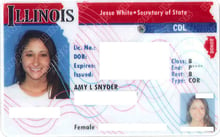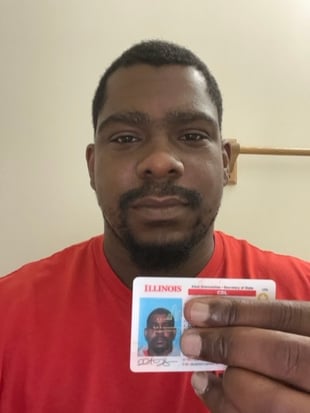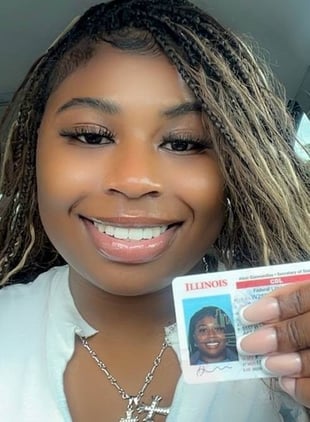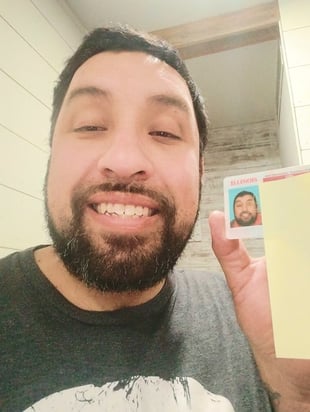

All your missed questions are saved
automatically for extra practice.




It's a practice test that's automatically made up of all your missed questions. Once you finish this test, you’ll be able to revisit your Challenge Bank™ to practice and sharpen your skills.
View All PlansAdding difficult questions to Challenge Bank™ is an exclusive Premium feature. Unlock access to 650+ exam-like questions, a Pass Guarantee, personalized study plans, and more.
View All PlansFree Illinois CDL Permit Practice Test: General Knowledge 2025
| 90-100 | => | 17% |
| 80-89 | => | 26% |
| 70-79 | => | 28% |
| 60-69 | => | 17% |
| <60% | => | 12% |
We’re glad you decided to take our free Illinois CDL permit practice test! This practice test will help you prepare to pass the official CDL General Knowledge test. By now, you’ve probably read a good deal of the official Illinois Commercial Driver’s License Study Guide (Illinois CDL Handbook 2025) at least once. By taking this practice test, you’ll absorb the relevant material and become more accustomed to being tested on it. The practice test is based on the official state CDL Study Guide, just like the official knowledge test. It is up to date as of December, 2025 and has 50 multiple-choice questions. The questions on this practice test will assess your understanding of such topics as cargo management, driving emergencies, vehicle components, and driving in various situations. However, this practice test differs from the official knowledge test in the extra features it provides to help you learn, including a hint and an explanation of the correct answer for each question, and an automated assistant for even more help.
By passing the official knowledge test, submitting to a medical examination, and meeting a few other requirements, you’ll be eligible to obtain a Commercial Learner’s Permit (CLP). This credential will allow you to practice commercial driving under the supervision of someone who already holds a Commercial Driver’s License (CDL).


Reviewed for legal and handbook accuracy
M.S., Chief Educational Researcher (ACES member)
Last verified for accuracy on
Real Illinois drivers who passed first try
Verified student reviews • Shared with permission



About the Illinois CDL
By practicing commercial driving, you’ll become sufficiently good at it to pass the official skills test, a necessary step for you to obtain a CDL. The skills test will evaluate you on performing basic vehicle maneuvers, a pre-trip inspection, and a road test.
There are three classes of CDLs: Class A is typically for large combination vehicles, such as semi-trucks and tractor-trailers. Class B is typically for single-unit vehicles, such as large buses and straight trucks, including box trucks and most dump trucks. Class C is typically for smaller commercial vehicles that transport hazardous materials or at least 16 occupants (including the driver), such as shuttle buses and small trucks carrying hazardous materials. Decide which class you want, based on the types of vehicles you expect to be driving commercially in your career.
Once you obtain a CDL and all endorsements you need, you can start earning money as a commercial driver. Illinois’ economy depends heavily on truck and bus traffic. Illinois has one of the greatest intermodal transportation hubs in America, including huge rail and highway networks and airports for air freight. Interstate 90 and Interstate 94, which intersect in Chicago, make up one of the busiest trucking routes in the country. Interstate 80 is another major commercial route.
But that future starts with you studying hard to pass that General Knowledge test and earn that CLP. Good luck!
More IL CDL test resources
Are you in another state?
- Alabama
- Alaska
- Arizona
- Arkansas
- California
- Colorado
- Connecticut
- Delaware
- District of Columbia
- Florida
- Georgia
- Hawaii
- Idaho
- Illinois
- Indiana
- Iowa
- Kansas
- Kentucky
- Louisiana
- Maine
- Maryland
- Massachusetts
- Michigan
- Minnesota
- Mississippi
- Missouri
- Montana
- Nebraska
- Nevada
- New Hampshire
- New Jersey
- New Mexico
- New York
- North Carolina
- North Dakota
- Ohio
- Oklahoma
- Oregon
- Pennsylvania
- Rhode Island
- South Carolina
- South Dakota
- Tennessee
- Texas
- Utah
- Vermont
- Virginia
- Washington
- West Virginia
- Wisconsin
- Wyoming
We know what it takes to pass. And we’ve got the proof.
Driver’s Ed is - nobody wants to set foot inside the DMV. That’s why millions of learners trust us for simple, visual, effective prep.
An official & trusted partner in driver education
We are an officially recognized FMCSA Entry-Level Driver Training provider and a proud partner to over 2,500 libraries. We work with safety organizations like GHSA and the National Safety Council to help create safer roads for everyone.






A smarter way to study
Challenge Bank™
Our trademarked system automatically saves questions you miss, creating personalized tests that target your weak spots until you’ve mastered the material.
AI-powered feedback
Get smarter as you study. Our new AI-powered feedback provides detailed, question-level insights to help you understand the why behind each answer.
Interactive handbook
Go beyond the boring black-and-white manual. Our interactive handbook lets you read, listen with an MP3 audio version, or even chat with it to find the information you need, faster.
We build our practice questions from the current 2025 IL Driver Handbook and refine them using patterns recent test‑takers report.
Driver handbook • Knowledge‑test/permit overview • Fees & ID requirements • Office/appointment info
We mirror recurring themes (e.g., right‑of‑way traps, sign look‑alikes) and use similar distractors and wording styles.
We don’t collect or publish actual test items and we’re not affiliated with DMV.
FAQs
How do you obtain a CDL in Illinois?
To get a CDL in Illinois, start by obtaining a commercial learner's permit (CLP) after passing the required knowledge tests. Hold the CLP for at least 14 days, then complete CDL training (optional but recommended) and pass the skills test. Ensure you meet all medical and legal requirements.
What is the cost of getting a CDL?
The cost for a CDL in Illinois includes a $50 fee for the CDL, plus additional fees for endorsements and CDL training programs, if you choose to enroll in one.
What are the different types of CDL?
In Illinois, CDL types include Class A (for combination vehicles), Class B (for heavy straight vehicles), and Class C (for vehicles designed to transport 16 or more passengers or hazardous materials).
What is the first step in getting a CDL?
The first step in getting a CDL in Illinois is to obtain a commercial learner's permit (CLP) by passing the written knowledge tests for the type of vehicle you plan to drive.
How long does CDL training last?
CDL training duration in Illinois varies by program. Typically, it can range from a few weeks to several months, depending on the type of training (full-time or part-time) and the specific requirements of the CDL class you are pursuing.
Is CDL school required in Illinois?
CDL school is not mandatory in Illinois, but it is highly recommended. Proper training can significantly increase your chances of passing the skills test and being better prepared for a career in commercial driving.

